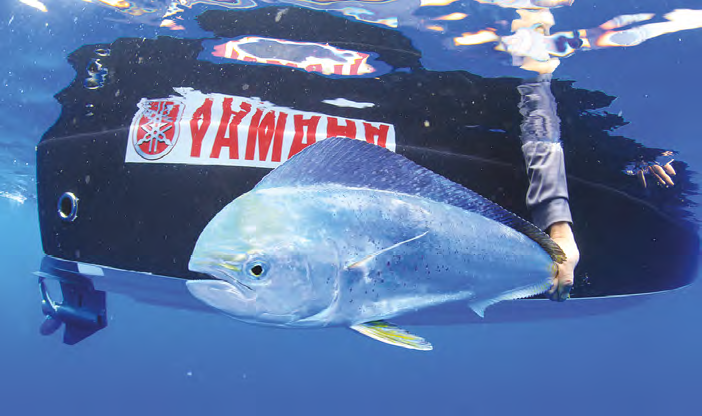
Mahi are some of the most colourful sportfish in the sea. A brilliant mix of gold, yellow, green and silver, interspersed with specks of iridescent blue, makes this lightweight pelagic a kaleidoscope of colour.
Not only are they a beautiful looking fish, they are also spectacular fighters. Like oceanic acrobats they spend more time in the air than in the water, cartwheeling wildly when hooked. What makes them even more popular is the fact that they are absolutely delicious on the plate.
A wide-ranging species, mahi are found throughout tropical and subtropical waters of the world’s three major oceans, from the coasts of Kenya to Florida. In Australia they are present all year round in the northern waters, especially around Queensland where they are prolific. During the summer and autumn months they make an annual migration south with the current into New South Wales waters, while on the west coast it is a similar situation, with the Leeuwin Current pushing mahi south past Perth during the warmer months.
Mahi live life in the fast lane – lasting just four years, apparently. So while the likes of wahoo and sailfish may be quicker, mahi definitely grow faster. A three-year-old fish can weigh well in excess of 30kg and stretch out more than 150cm in length. Understandably, they are ferocious feeders and will eat just about anything that swims, from flying fish to baby tuna and, not surprisingly, are reputed to be one of the fastest growing fish in the sea. Spawning occurs in the open ocean off Queensland in waters that are around 25°C.
Males and females are easily distinguishable from one another. Males, known as bulls, have a very square, flat forehead that is very obvious. Alternatively, females, known as cows, have a much more rounded forehead that slopes backwards. The bigger the fish the easier they are to tell apart.

FISHING TRICKS
Trolling is the easiest way to catch mahi. Small skirted lures like Christmas trees, jet heads and little pushers are ideal. Trolled in conjunction with some deep divers such as Laser Pros and Halco Max’s they make a deadly spread. Best trolled at six and eight knots you can pick up mahi anywhere in open water.
Seabirds will point you towards feeding mahi. If you see a frigate bird or a couple of small white terns hovering about, especially in tropical waters, chances are, they will be over predators like mahi. Another sure sign is when you see a patch of flying fish exploding out of the water. Of course, anything you find floating is always worth trolling past.
Mahi also respond well to bait. Chopped-up fish bits, especially pilchards and tuna, will quickly have them swirling around excitedly at the back of the boat. Concealing a 4/0 live bait hook into a cube and then floating it out the back will rarely get refused. Being able to see the bite makes this a very exciting style of fishing.
Don’t use a heavy leader, instead 20- 40kg trace is more than adequate and will fool most mahi. If the fish keep rejecting your offering then try downsizing the hook and really concealing it in the bait.
Without doubt the most deadly of all the methods for catching mahi is live baiting, especially with small slimies or yakkas. I can’t recall a single occasion when a live bait has been refused by a dolphin fish. It doesn’t seem to matter what type you offer them – as long as it is alive and kicking they will pounce on it.
Big live baits are also the best way to get past the smaller mahi. Fishing with cubes can be frustrating because the smaller fish always seem to beat the bigger fish to the bait. Large live baits are selective and, since they are too big for the smaller fish to take on, they generally only catch the big mahi.
The rig is the same as you would use when cubing, except you employ a larger hook, usually a 6/0 to 8/0 circle hook. Simplicity is the key, so avoid heavy leaders, sinkers or floats, which just complicate matters. The bigger dolphin fish are usually shy so it is best to cast or drift the live baits well away from the boat. Trolling skip baits is also highly effective, especially on really big mahi. Slimy mackerel and bonito rigged on fine gauge circle hooks will ensure the best strike rate.
The best thing about mahi is they are great fun to catch but better still are sensational on the plate as well. And I tell you it’s tough to beat a feed of fresh grilled mahi with salad and a beer.
Category: Unknown
Written: Fri 01 Apr 2016
Printed: April, 2016
Published By:
AL MCGLASHAN